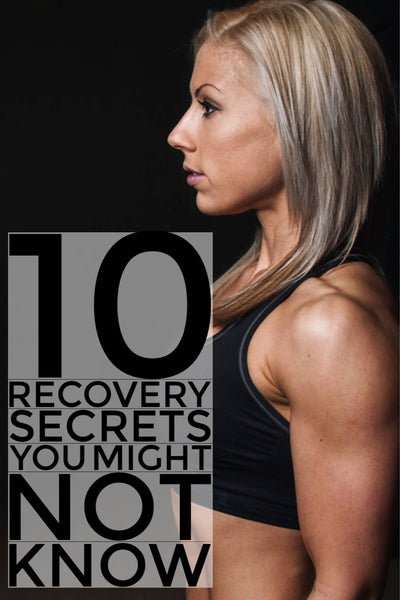10 Recovery Secrets You Might Not Know
We talk about recovery a lot on the blog, but it's still something people struggle with.
Do you ever wonder how the top athletes can train multiple times per day, at a high intensity? Their recovery game must be pretty strong, right?
There's a lot more to recovery than good nutrition and a post-WOD shake. Don't get us wrong - both of these are important, but they'll only get you so far.

If you want to recover faster between WODs, here are 10 more things for you to try:
1. Take an Epsom Salt Bath
Epsom salt, or magnesium sulphite, is a mineral compound easily absorbed by the skin. Both minerals, magnesium and sulphate, can play a role in your post-WOD recovery.
Some of the benefits linked to epsom salt baths include:
- Reducing inflammation,
- Muscle relaxation,
- Flushing toxins from the body.
2. Go For a Sports Massage
Most professional athletes have a massage therapist on their team for a reason - it works!
A sports massage can prevent, or help alleviate, DOMS by encouraging blood flow to the affected muscles.
They're also thought to eliminate lactic and carbonic acid build up from the muscles, further reducing your recovery time.
3. Increase Your Intake of Omega-3
When it comes to supplementation, you need to think beyond BCAAs and protein shakes to maximise your recovery.
Fish oils have many health benefits, and are a staple supplement for many CrossFit Games athletes.
To find out why, check out this article.
4. Replace lost electrolytes
When you train, your body loses electrolytes as you sweat. It's important to replace them to maintain the correct fluid balance within your body and support recovery.
Here are some things you can consume post-WOD to replace them:
- Bananas,
- Coconut water,
- Avocados,
- Kale,
- A pinch of salt in your post-WOD recovery drink.
5. Cryotherapy
Cryotherapy involves the use of extreme cold temperatures to reduce inflammation and speed up recovery. Have you ever seen an athlete jumping into an ice bath following an event? This is cryotherapy - although, in the real world, it doesn't have to be quite so extreme.
Cryotherapy is recommended to treat injuries, but many athletes use it as a recovery tool too.
It works by removing lactic acid (and other waste products) from the muscles, whilst reducing inflammation and muscle damage.
6. Stay Hydrated
This sounds very simple - and it is! But it's amazing how many people fail to do the most obvious things to improve recovery.
Hydration is always important, but it's absolutely essential when your body's recovering from a tough WOD.
7. Get More Sleep
Again, we all know sleep is important - but this could be the missing link in your recovery regime.
If you're taking too long to recover between sessions, try to get to bed an hour earlier each night. It might not sound like a lot, but this adds up to an extra 7 hours over the course of the week. An extra 7 hours of intense recovery for your WOD ravaged muscles!
8. Try Yoga for Active Recovery
Regular weightlifting can lead to chronic muscle tightness, and muscular imbalances - especially if you haven't got your technique dialled all the way in.
Over time, this can impact your training and increase the risk of injury - hence the need for regular mobility work.
A yoga class is a great way to add some balance to your routine and work on your mobility.
It's a restorative exercise, so most classes are suitable for active recovery days. If you find the right instructor, it will help you build strength too - as many of the poses are challenging.
9. Take a Magnesium Supplement
Magnesium is another underestimated supplement for recovery. It's most commonly taken in the form of a ZMA supplement, which also contains zinc.
Magnesium contributes to over 300 chemical processes within the body, including those related to muscle recovery.
Magnesium has been found to relax muscles post-workout. It also improves oxygen uptake and electrolyte balance within the muscles, and improves sleep quality.
10. Compression
Research suggests wearing compression gear reduces the severity of DOMS following an intense workout. The study also evaluated the impact on muscle strength and muscle power.
They concluded that compression clothing is effective when it comes to speeding up recovery from muscle damage.
Ready to Improve Your Recovery Game?
Check out some of the products mentioned in this post:
Pin This Post:


